Business Law Assignment: Obligations, Liabilities, and Negligence
VerifiedAdded on 2020/05/11
|5
|1298
|75
Report
AI Summary
This business law assignment analyzes a scenario involving a restaurant and its legal obligations. Part A examines the restaurant owner's obligations concerning a disruptive customer (Larry), staff, and other clients, focusing on potential remedies and vicarious liability. Part B delves into the liability for Larry's injuries, exploring the tort of negligence, including the elements of breach of duty of care and the application of the Civil Liability Act 2002. The analysis also considers contributory negligence, discussing how Larry's actions may impact the determination of damages under the WRONGS ACT 1958. The assignment provides a comprehensive overview of legal principles and their application in a business context, supported by relevant case law and legislation.
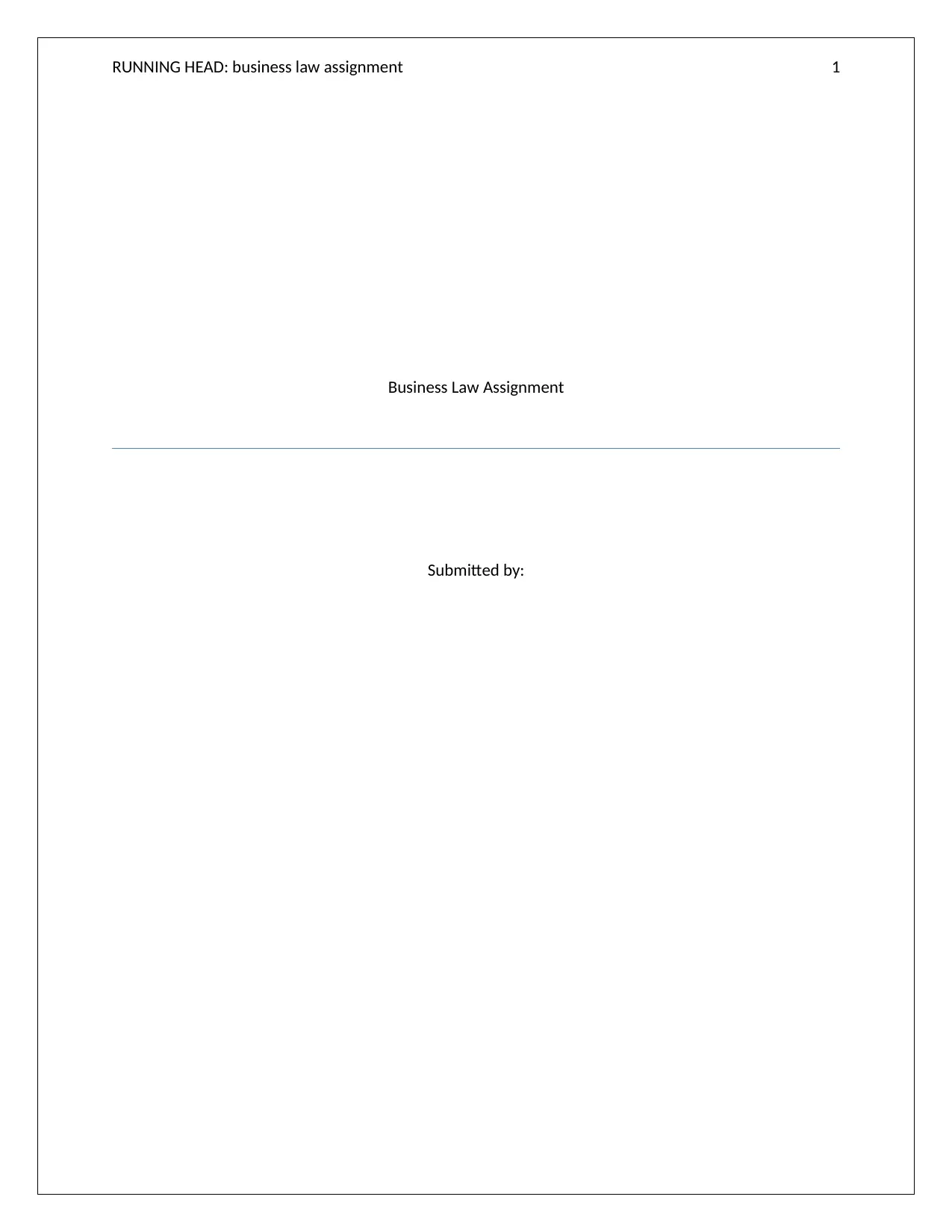
RUNNING HEAD: business law assignment 1
Business Law Assignment
Submitted by:
Business Law Assignment
Submitted by:
Paraphrase This Document
Need a fresh take? Get an instant paraphrase of this document with our AI Paraphraser
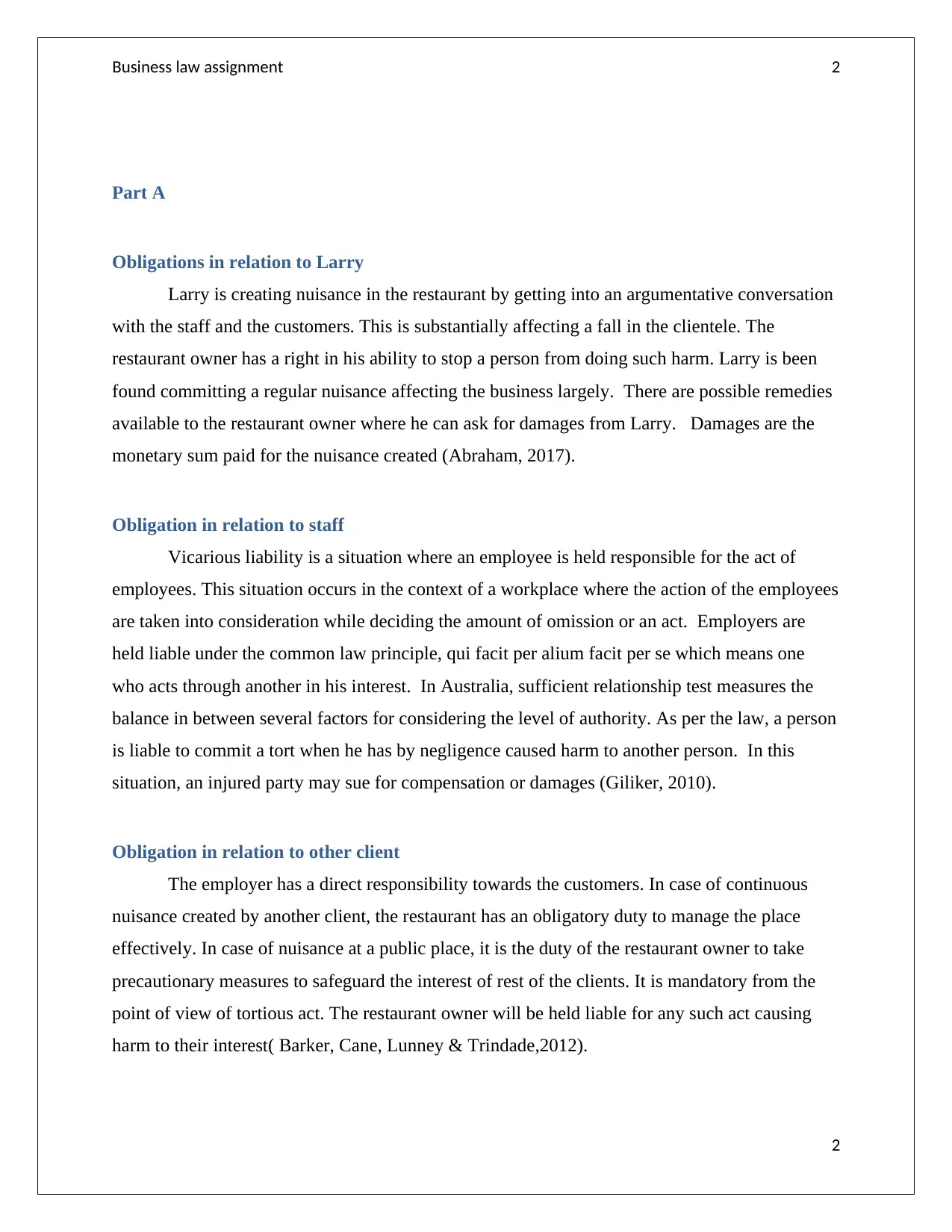
Business law assignment 2
Part A
Obligations in relation to Larry
Larry is creating nuisance in the restaurant by getting into an argumentative conversation
with the staff and the customers. This is substantially affecting a fall in the clientele. The
restaurant owner has a right in his ability to stop a person from doing such harm. Larry is been
found committing a regular nuisance affecting the business largely. There are possible remedies
available to the restaurant owner where he can ask for damages from Larry. Damages are the
monetary sum paid for the nuisance created (Abraham, 2017).
Obligation in relation to staff
Vicarious liability is a situation where an employee is held responsible for the act of
employees. This situation occurs in the context of a workplace where the action of the employees
are taken into consideration while deciding the amount of omission or an act. Employers are
held liable under the common law principle, qui facit per alium facit per se which means one
who acts through another in his interest. In Australia, sufficient relationship test measures the
balance in between several factors for considering the level of authority. As per the law, a person
is liable to commit a tort when he has by negligence caused harm to another person. In this
situation, an injured party may sue for compensation or damages (Giliker, 2010).
Obligation in relation to other client
The employer has a direct responsibility towards the customers. In case of continuous
nuisance created by another client, the restaurant has an obligatory duty to manage the place
effectively. In case of nuisance at a public place, it is the duty of the restaurant owner to take
precautionary measures to safeguard the interest of rest of the clients. It is mandatory from the
point of view of tortious act. The restaurant owner will be held liable for any such act causing
harm to their interest( Barker, Cane, Lunney & Trindade,2012).
2
Part A
Obligations in relation to Larry
Larry is creating nuisance in the restaurant by getting into an argumentative conversation
with the staff and the customers. This is substantially affecting a fall in the clientele. The
restaurant owner has a right in his ability to stop a person from doing such harm. Larry is been
found committing a regular nuisance affecting the business largely. There are possible remedies
available to the restaurant owner where he can ask for damages from Larry. Damages are the
monetary sum paid for the nuisance created (Abraham, 2017).
Obligation in relation to staff
Vicarious liability is a situation where an employee is held responsible for the act of
employees. This situation occurs in the context of a workplace where the action of the employees
are taken into consideration while deciding the amount of omission or an act. Employers are
held liable under the common law principle, qui facit per alium facit per se which means one
who acts through another in his interest. In Australia, sufficient relationship test measures the
balance in between several factors for considering the level of authority. As per the law, a person
is liable to commit a tort when he has by negligence caused harm to another person. In this
situation, an injured party may sue for compensation or damages (Giliker, 2010).
Obligation in relation to other client
The employer has a direct responsibility towards the customers. In case of continuous
nuisance created by another client, the restaurant has an obligatory duty to manage the place
effectively. In case of nuisance at a public place, it is the duty of the restaurant owner to take
precautionary measures to safeguard the interest of rest of the clients. It is mandatory from the
point of view of tortious act. The restaurant owner will be held liable for any such act causing
harm to their interest( Barker, Cane, Lunney & Trindade,2012).
2
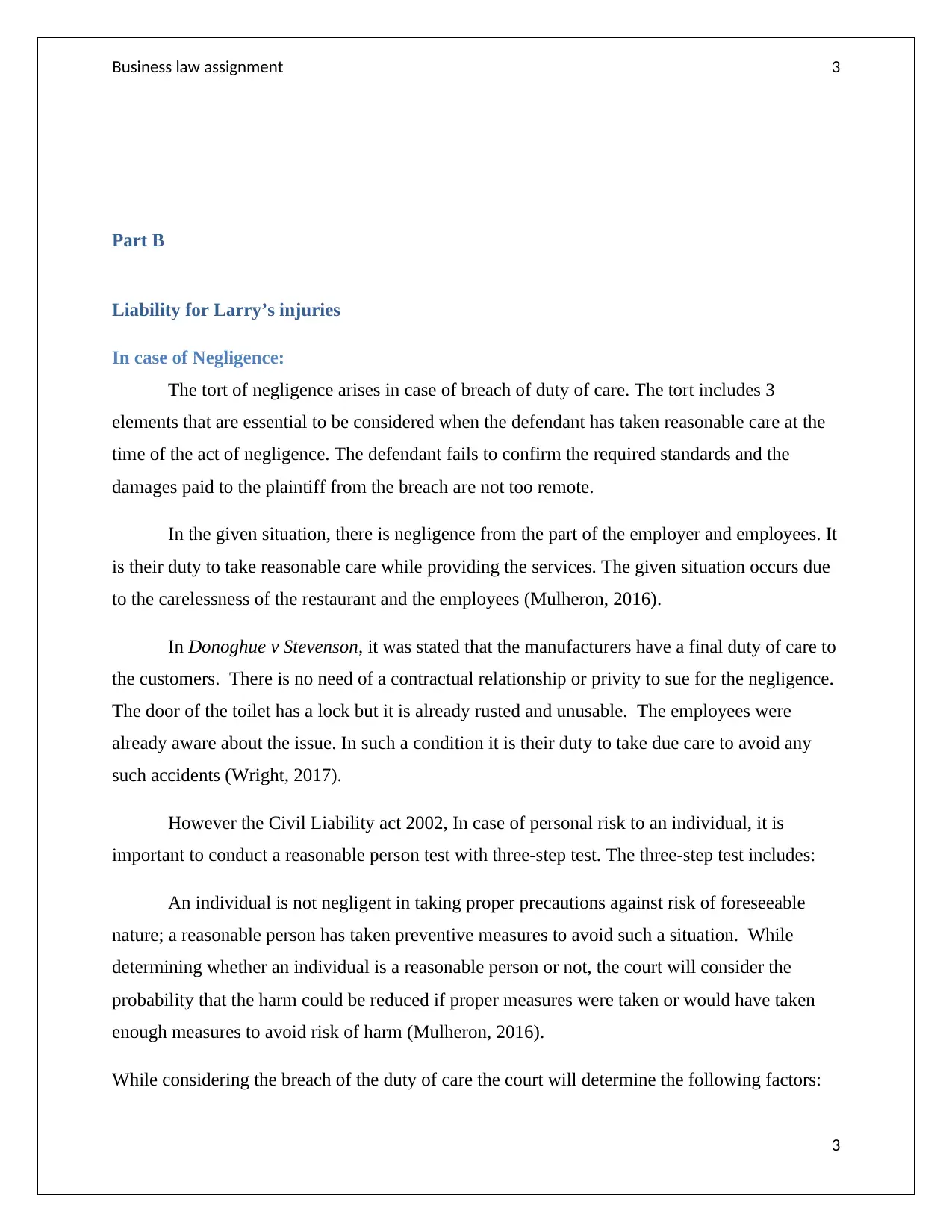
Business law assignment 3
Part B
Liability for Larry’s injuries
In case of Negligence:
The tort of negligence arises in case of breach of duty of care. The tort includes 3
elements that are essential to be considered when the defendant has taken reasonable care at the
time of the act of negligence. The defendant fails to confirm the required standards and the
damages paid to the plaintiff from the breach are not too remote.
In the given situation, there is negligence from the part of the employer and employees. It
is their duty to take reasonable care while providing the services. The given situation occurs due
to the carelessness of the restaurant and the employees (Mulheron, 2016).
In Donoghue v Stevenson, it was stated that the manufacturers have a final duty of care to
the customers. There is no need of a contractual relationship or privity to sue for the negligence.
The door of the toilet has a lock but it is already rusted and unusable. The employees were
already aware about the issue. In such a condition it is their duty to take due care to avoid any
such accidents (Wright, 2017).
However the Civil Liability act 2002, In case of personal risk to an individual, it is
important to conduct a reasonable person test with three-step test. The three-step test includes:
An individual is not negligent in taking proper precautions against risk of foreseeable
nature; a reasonable person has taken preventive measures to avoid such a situation. While
determining whether an individual is a reasonable person or not, the court will consider the
probability that the harm could be reduced if proper measures were taken or would have taken
enough measures to avoid risk of harm (Mulheron, 2016).
While considering the breach of the duty of care the court will determine the following factors:
3
Part B
Liability for Larry’s injuries
In case of Negligence:
The tort of negligence arises in case of breach of duty of care. The tort includes 3
elements that are essential to be considered when the defendant has taken reasonable care at the
time of the act of negligence. The defendant fails to confirm the required standards and the
damages paid to the plaintiff from the breach are not too remote.
In the given situation, there is negligence from the part of the employer and employees. It
is their duty to take reasonable care while providing the services. The given situation occurs due
to the carelessness of the restaurant and the employees (Mulheron, 2016).
In Donoghue v Stevenson, it was stated that the manufacturers have a final duty of care to
the customers. There is no need of a contractual relationship or privity to sue for the negligence.
The door of the toilet has a lock but it is already rusted and unusable. The employees were
already aware about the issue. In such a condition it is their duty to take due care to avoid any
such accidents (Wright, 2017).
However the Civil Liability act 2002, In case of personal risk to an individual, it is
important to conduct a reasonable person test with three-step test. The three-step test includes:
An individual is not negligent in taking proper precautions against risk of foreseeable
nature; a reasonable person has taken preventive measures to avoid such a situation. While
determining whether an individual is a reasonable person or not, the court will consider the
probability that the harm could be reduced if proper measures were taken or would have taken
enough measures to avoid risk of harm (Mulheron, 2016).
While considering the breach of the duty of care the court will determine the following factors:
3
⊘ This is a preview!⊘
Do you want full access?
Subscribe today to unlock all pages.

Trusted by 1+ million students worldwide
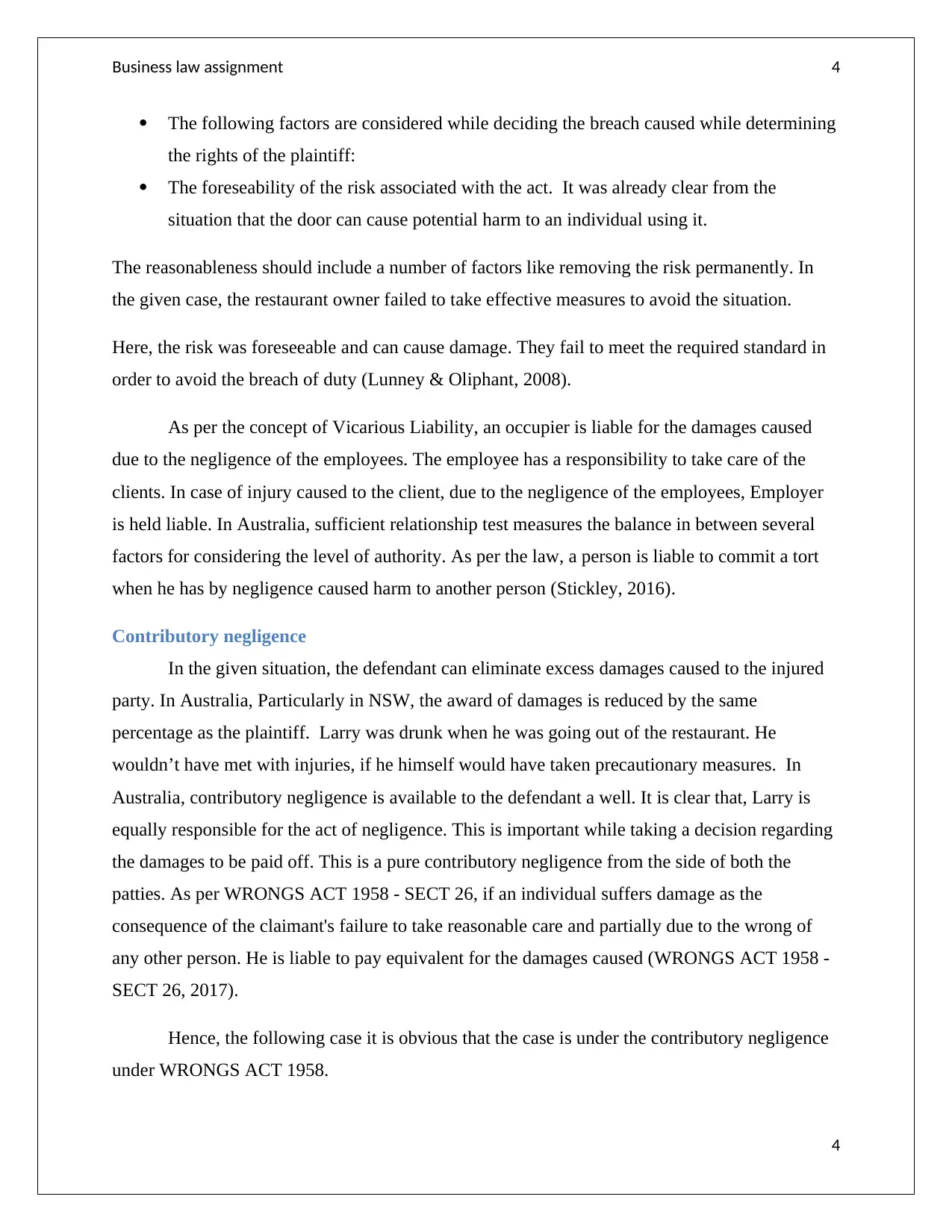
Business law assignment 4
The following factors are considered while deciding the breach caused while determining
the rights of the plaintiff:
The foreseability of the risk associated with the act. It was already clear from the
situation that the door can cause potential harm to an individual using it.
The reasonableness should include a number of factors like removing the risk permanently. In
the given case, the restaurant owner failed to take effective measures to avoid the situation.
Here, the risk was foreseeable and can cause damage. They fail to meet the required standard in
order to avoid the breach of duty (Lunney & Oliphant, 2008).
As per the concept of Vicarious Liability, an occupier is liable for the damages caused
due to the negligence of the employees. The employee has a responsibility to take care of the
clients. In case of injury caused to the client, due to the negligence of the employees, Employer
is held liable. In Australia, sufficient relationship test measures the balance in between several
factors for considering the level of authority. As per the law, a person is liable to commit a tort
when he has by negligence caused harm to another person (Stickley, 2016).
Contributory negligence
In the given situation, the defendant can eliminate excess damages caused to the injured
party. In Australia, Particularly in NSW, the award of damages is reduced by the same
percentage as the plaintiff. Larry was drunk when he was going out of the restaurant. He
wouldn’t have met with injuries, if he himself would have taken precautionary measures. In
Australia, contributory negligence is available to the defendant a well. It is clear that, Larry is
equally responsible for the act of negligence. This is important while taking a decision regarding
the damages to be paid off. This is a pure contributory negligence from the side of both the
patties. As per WRONGS ACT 1958 - SECT 26, if an individual suffers damage as the
consequence of the claimant's failure to take reasonable care and partially due to the wrong of
any other person. He is liable to pay equivalent for the damages caused (WRONGS ACT 1958 -
SECT 26, 2017).
Hence, the following case it is obvious that the case is under the contributory negligence
under WRONGS ACT 1958.
4
The following factors are considered while deciding the breach caused while determining
the rights of the plaintiff:
The foreseability of the risk associated with the act. It was already clear from the
situation that the door can cause potential harm to an individual using it.
The reasonableness should include a number of factors like removing the risk permanently. In
the given case, the restaurant owner failed to take effective measures to avoid the situation.
Here, the risk was foreseeable and can cause damage. They fail to meet the required standard in
order to avoid the breach of duty (Lunney & Oliphant, 2008).
As per the concept of Vicarious Liability, an occupier is liable for the damages caused
due to the negligence of the employees. The employee has a responsibility to take care of the
clients. In case of injury caused to the client, due to the negligence of the employees, Employer
is held liable. In Australia, sufficient relationship test measures the balance in between several
factors for considering the level of authority. As per the law, a person is liable to commit a tort
when he has by negligence caused harm to another person (Stickley, 2016).
Contributory negligence
In the given situation, the defendant can eliminate excess damages caused to the injured
party. In Australia, Particularly in NSW, the award of damages is reduced by the same
percentage as the plaintiff. Larry was drunk when he was going out of the restaurant. He
wouldn’t have met with injuries, if he himself would have taken precautionary measures. In
Australia, contributory negligence is available to the defendant a well. It is clear that, Larry is
equally responsible for the act of negligence. This is important while taking a decision regarding
the damages to be paid off. This is a pure contributory negligence from the side of both the
patties. As per WRONGS ACT 1958 - SECT 26, if an individual suffers damage as the
consequence of the claimant's failure to take reasonable care and partially due to the wrong of
any other person. He is liable to pay equivalent for the damages caused (WRONGS ACT 1958 -
SECT 26, 2017).
Hence, the following case it is obvious that the case is under the contributory negligence
under WRONGS ACT 1958.
4
Paraphrase This Document
Need a fresh take? Get an instant paraphrase of this document with our AI Paraphraser
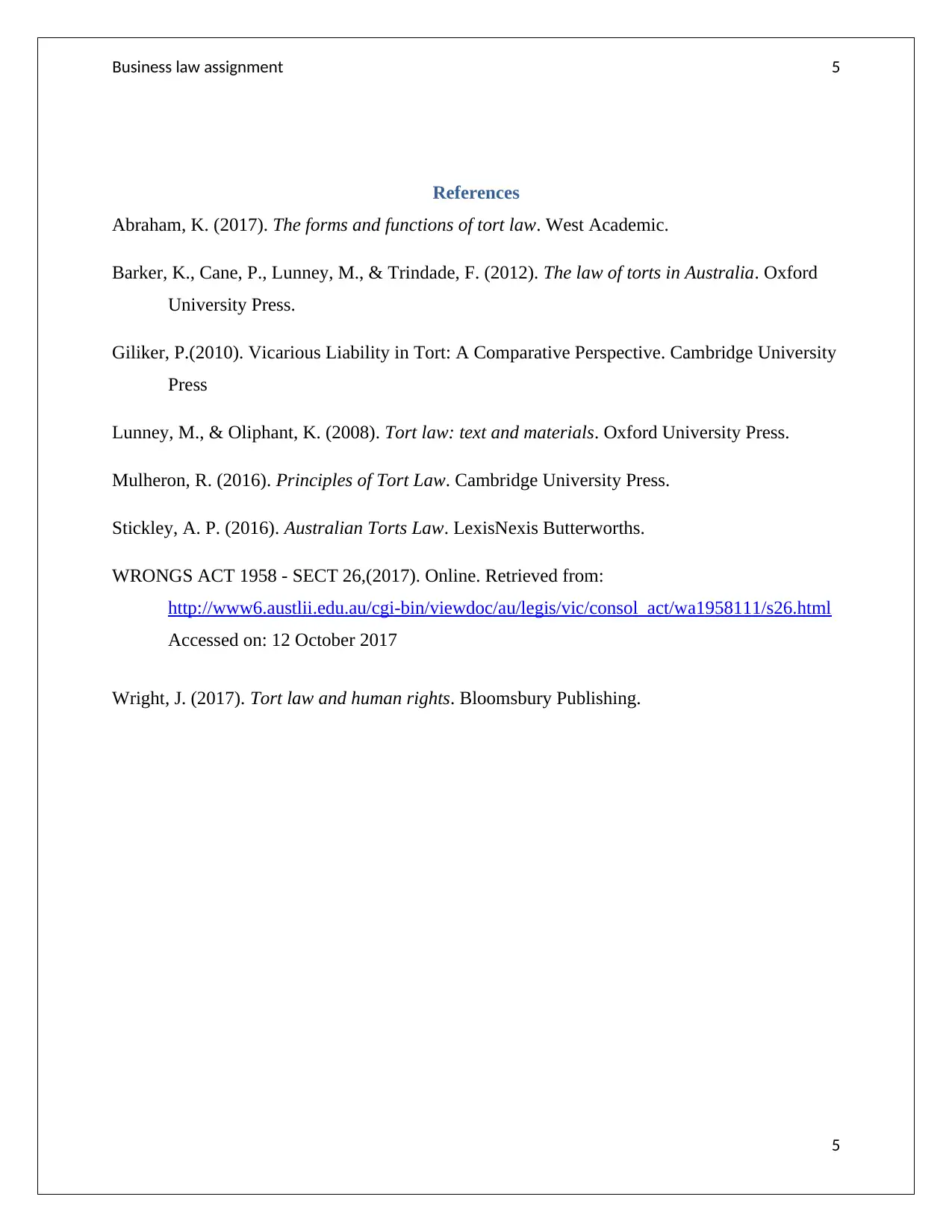
Business law assignment 5
References
Abraham, K. (2017). The forms and functions of tort law. West Academic.
Barker, K., Cane, P., Lunney, M., & Trindade, F. (2012). The law of torts in Australia. Oxford
University Press.
Giliker, P.(2010). Vicarious Liability in Tort: A Comparative Perspective. Cambridge University
Press
Lunney, M., & Oliphant, K. (2008). Tort law: text and materials. Oxford University Press.
Mulheron, R. (2016). Principles of Tort Law. Cambridge University Press.
Stickley, A. P. (2016). Australian Torts Law. LexisNexis Butterworths.
WRONGS ACT 1958 - SECT 26,(2017). Online. Retrieved from:
http://www6.austlii.edu.au/cgi-bin/viewdoc/au/legis/vic/consol_act/wa1958111/s26.html
Accessed on: 12 October 2017
Wright, J. (2017). Tort law and human rights. Bloomsbury Publishing.
5
References
Abraham, K. (2017). The forms and functions of tort law. West Academic.
Barker, K., Cane, P., Lunney, M., & Trindade, F. (2012). The law of torts in Australia. Oxford
University Press.
Giliker, P.(2010). Vicarious Liability in Tort: A Comparative Perspective. Cambridge University
Press
Lunney, M., & Oliphant, K. (2008). Tort law: text and materials. Oxford University Press.
Mulheron, R. (2016). Principles of Tort Law. Cambridge University Press.
Stickley, A. P. (2016). Australian Torts Law. LexisNexis Butterworths.
WRONGS ACT 1958 - SECT 26,(2017). Online. Retrieved from:
http://www6.austlii.edu.au/cgi-bin/viewdoc/au/legis/vic/consol_act/wa1958111/s26.html
Accessed on: 12 October 2017
Wright, J. (2017). Tort law and human rights. Bloomsbury Publishing.
5
1 out of 5
Related Documents
Your All-in-One AI-Powered Toolkit for Academic Success.
+13062052269
info@desklib.com
Available 24*7 on WhatsApp / Email
![[object Object]](/_next/static/media/star-bottom.7253800d.svg)
Unlock your academic potential
Copyright © 2020–2025 A2Z Services. All Rights Reserved. Developed and managed by ZUCOL.




